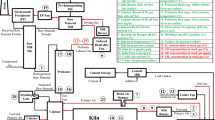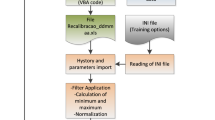Abstract
Oxygen content in the flue gas system of power plants is an essential factor affecting boiler efficiency. Accurate oxygen content measurement is vital in evaluating boiler combustion efficiency. The device measuring oxygen content in flue gases at an oil refinery uses a Zirconia oxygen analyzer. This sensor utilization without sensor redundancy makes the oxygen content measurement conducted manually. Workers’ manual measurement is risky because it is a high-risk work area. In addition, the oxygen content in flue gas also indicates boiler combustion efficiency and the amount of other harmful gases produced by the boiler. This paper proposes a soft sensor using artificial neural networks (ANN) and extreme gradient boosting (XGBoost) to predict oxygen content. The dataset used is collected from the historical data of the distributed control system of an oil refinery system boiler. The experimental results show that the one hidden layer ANN model achieves an MAE of 0.0715 and RMSE of 0.0935, while the XGBoost model with hyperparameter tuning and seven features achieves an MAE of 0.0452 and RMSE of 0.0642. The results suggest that the XGBoost model with hyperparameter tuning and seven features outperforms the one hidden layer ANN model. The use of the seven features of the XGBoost model is the result of optimization between computational complexity and system performance.








Similar content being viewed by others
Explore related subjects
Discover the latest articles and news from researchers in related subjects, suggested using machine learning.Data availability
The dataset used in the study is available from the corresponding author on reasonable request for non-commercial use.
References
Liu Y, Fan Y, Chen J (2017) Flame images for oxygen content prediction of combustion systems using DBN. Energy Fuels 31(8):8776–8783. https://doi.org/10.1021/acs.energyfuels.7b00576
Lutterbeck CA, da Silveira Garcia D, Colares GS, Kist LT, Machado ÊL (2021) Environmental and economic impacts associated with the use of boilers of a steam generator system at a tobacco manufacturing industry. Environ Challenges 5:100323. https://doi.org/10.1016/j.envc.2021.100323
Taler D, Dzierwa P, Kaczmarski K, Taler J (2022) Increase the flexibility of steam boilers by optimisation of critical pressure component heating. Energy 250:123855. https://doi.org/10.1016/j.energy.2022.123855
Ma L, Zuo X, Wang Y (2019) Boiler oxygen optimization based on double-hidden-layer bp neural network and improved pso algorithm. In: 1st International conference on industrial artificial intelligence, IAI 2019. https://doi.org/10.1109/ICIAI.2019.8850735
Wang YF et al (2021) Fuzzy modeling of boiler efficiency in power plants. Inform Sci 542:391–405. https://doi.org/10.1016/j.ins.2020.06.064
Camaraza-Medina Y, Retirado-Mediaceja Y, Hernandez-Guerrero A, Luis Luviano-Ortiz J (2021) Energy efficiency indicators of the steam boiler in a power plant of Cuba. Therm Sci Eng Progress 23:100880. https://doi.org/10.1016/j.tsep.2021.100880
Lyubov VK (2020) Influence of coal combustion technology on boiler operation efficiency. Solid Fuel Chem 54(5):260–268. https://doi.org/10.3103/S0361521920050067
Tang Z, Zhang H, Yang H (2017) Artificial neural networks model for predicting oxygen content in flue gas of power plant. In: Proceedings of the 29th Chinese control and decision conference, CCDC 2017, pp 1379–1382. https://doi.org/10.1109/CCDC.2017.7978732
Jiang Y, Lee B-H, Oh D-H, Jeon C-H (2022) Influence of various air-staging on combustion and NOX emission characteristics in a tangentially fired boiler under the 50% load condition. Energy. https://doi.org/10.1016/j.energy.2022.123167
Adams D, Oh D-H, Kim D-W, Lee C-H, Oh M (2020) Prediction of SOx–NOx emission from a coal-fired CFB power plant with machine learning: Plant data learned by deep neural network and least square support vector machine. J Clean Prod 270:122310. https://doi.org/10.1016/j.jclepro.2020.122310
Liangyu M, Yongjun W, Xiaotong Z (2019) ANN-based soft sensing of oxygen content in boiler air-flue gas system. In: Proceedings of the 31st Chinese control and decision conference, CCDC 2019, pp 3268–3272. https://doi.org/10.1109/CCDC.2019.8833411
Lebukan DEP, Wardana ANI, Effendy N (2019) Implementation of Plant-Wide PI-Fuzzy controller in tennessee eastman process. In: International seminar on application for technology of information and communication (iSemantic), pp 450–454
Nafisah S, Effendy N (2019) Voice biometric system: the identification of the severity of cerebral palsy using mel-frequencies stochastics approach. Int J Integr Eng. https://doi.org/10.30880/ijie.2019.11.03.020
Effendy N, Ruhyadi D, Pratama R, Rabba DF, Aulia AF, Atmadja AY (2022) Forest quality assessment based on bird sound recognition using convolutional neural networks. Int J Electr Comput Eng (IJECE). https://doi.org/10.11591/ijece.v12i4.pp4235-4242
Galvani RY, Effendy N, Kusumawanto A (2018) Evaluating weight priority on green building using fuzzy AHP. In: 12th South East Asian Technical University Consortium (SEATUC), vol 1, pp 1–6. https://doi.org/10.1109/SEATUC.2018.8788887
Sembodo SN, Effendy N, Dwiantoro K, Muddin N (2022) Radial basis network estimator of oxygen content in the flue gas of debutanizer reboiler. Int J Electr Comput Eng (IJECE) 12(3):3044–3050. https://doi.org/10.11591/ijece.v12i3.pp3044-3050
Pan H, Su T, Huang X, Wang Z (2021) LSTM-based soft sensor design for oxygen content of flue gas in coal-fired power plant. Trans Inst Meas Control 43(1):78–87. https://doi.org/10.1177/0142331220932390
Tang Z, Li Y, Kusiak A (2020) A deep learning model for measuring oxygen content of boiler flue gas. IEEE Access 8:12268–12278. https://doi.org/10.1109/ACCESS.2020.2965199
Tang Z, Chai X, Zhao B (2019) Deep neural network based the oxygen content of boiler flue gas. In: Chinese Automation Congress (CAC), pp 1720–1724. https://doi.org/10.1109/CAC48633.2019.8996241
Ambhore N, Kamble D (2020) Experimental investigation of tool wear and induced vibration in turning high hardness AISI52100 steel using cutting parameters and tool acceleration. Facta Univ Ser Mech Eng 18:623–637. https://doi.org/10.22190/FUME200116018A
Tian Z, Wang J (2022) Variable frequency wind speed trend prediction system based on combined neural network and improved multi-objective optimization algorithm. Energy 254:124249. https://doi.org/10.1016/j.energy.2022.124249
Lu F et al (2022) Prediction of amorphous forming ability based on artificial neural network and convolutional neural network. Comput Mater Sci 210:111464. https://doi.org/10.1016/j.commatsci.2022.111464
Tian J, Liu Y, Zheng W, Yin L (2022) Smog prediction based on the deep belief - BP neural network model (DBN-BP). Urban Clim 41:101078. https://doi.org/10.1016/j.uclim.2021.101078
Liu X, Liu T, Feng P (2022) Long-term performance prediction framework based on XGBoost decision tree for pultruded FRP composites exposed to water, humidity and alkaline solution. Compos Struct 284:115184. https://doi.org/10.1016/j.compstruct.2022.115184
Zhu X, Chu J, Wang K, Wu S, Yan W, Chiam K (2021) Prediction of rockhead using a hybrid N-XGBoost machine learning framework. J Rock Mech Geotech Eng 13(6):1231–1245. https://doi.org/10.1016/j.jrmge.2021.06.012
Wu Y et al (2022) Novel binary logistic regression model based on feature transformation of XGBoost for type 2 Diabetes Mellitus prediction in healthcare systems. Future Gen Comput Syst 129:1–12. https://doi.org/10.1016/j.future.2021.11.003
Shi R, Xu X, Li J, Li Y (2021) Prediction and analysis of train arrival delay based on XGBoost and Bayesian optimization. Appl Soft Comput 109:107538. https://doi.org/10.1016/j.asoc.2021.107538
Effendy N, Kurniawan ED, Dwiantoro K, Arif A, Muddin N (2022) The prediction of oxygen content of the flue gas in a gas-fired boiler system using neural networks and random forest. IAES Int J Artif Intell (IJ-AI) 11(3):923–929. https://doi.org/10.11591/ijai.v11.i3.pp923-929
Heo S, Lee JH (2018) Fault detection and classification using artificial neural networks. IFAC-PapersOnLine 51(18):470–475. https://doi.org/10.1016/j.ifacol.2018.09.380
MohdAmiruddin AAA, Zabiri H, Taqvi SAA, Tufa LD (2020) Neural network applications in fault diagnosis and detection: an overview of implementations in engineering-related systems. Neural Comput Appl 32(2):447–472. https://doi.org/10.1007/s00521-018-3911-5
Kumar SR, Devakumar J (2022) Performance evaluation of neural network topologies for online state estimation and fault detection in pressurized water reactor. Ann Nuclear Energy 175:109235. https://doi.org/10.1016/j.anucene.2022.109235
Yu J, Zhang C, Wang S (2021) Multichannel one-dimensional convolutional neural network-based feature learning for fault diagnosis of industrial processes. Neural Comput Appl 33(8):3085–3104. https://doi.org/10.1007/s00521-020-05171-4
Amosov OS, Amosova SG, Ivanov YS, Zhiganov SV (2021) Using the deep neural networks for normal and abnormal situation recognition in the automatic access monitoring and control system of vehicles. Neural Comput Appl 33(8):3069–3083. https://doi.org/10.1007/s00521-020-05170-5
Effendy N, Wachidah NC, Achmad B, Jiwandono P, Subekti M (2016) Power estimation of G.A. Siwabessy Multi-Purpose Reactor at start-up condition using artificial neural network with input variation. In: 2nd International conference on science and technology-computer (ICST), pp 133–138
Effendy N, Shinoda K, Furui S, Jitapunkul S (2009) Automatic recognition of Indonesian declarative questions and statements using polynomial coefficients of the pitch contours. Acoust Sci Technol 30:249–256. https://doi.org/10.1250/ast.30.249
Bidar B, Sadeghi J, Shahraki F, Khalilipour MM (2017) Data-driven soft sensor approach for online quality prediction using state dependent parameter models. Chemom Intell Lab Syst 162:130–141. https://doi.org/10.1016/j.chemolab.2017.01.004
Mowbray M et al (2022) Probabilistic machine learning based soft-sensors for product quality prediction in batch processes. Chemom Intell Lab Syst 228:104616. https://doi.org/10.1016/j.chemolab.2022.104616
Li Z, Jin H, Dong S, Qian B, Yang B, Chen X (2022) Semi-supervised ensemble support vector regression based soft sensor for key quality variable estimation of nonlinear industrial processes with limited labeled data. Chem Eng Res Des 179:510–526. https://doi.org/10.1016/j.cherd.2022.01.026
Wang C, Li Y, Huang K, Yang C, Gui W (2022) VAE4RSS: A VAE-based neural network approach for robust soft sensor with application to zinc roasting process. Eng Appl Artif Intell 114:105180. https://doi.org/10.1016/j.engappai.2022.105180
Ching PML, Zou X, Wu D, So RHY, Chen GH (2022) Development of a wide-range soft sensor for predicting wastewater BOD5 using an eXtreme gradient boosting (XGBoost) machine. Environ Res 210:112953. https://doi.org/10.1016/j.envres.2022.112953
Mohanta HK, Pani AK (2022) Adaptive non-linear soft sensor for quality monitoring in refineries using Just-in-Time Learning—Generalized regression neural network approach. Appl Soft Comput 119:108546. https://doi.org/10.1016/j.asoc.2022.108546
Gilman GF (2010) Boiler control systems engineering. International Society of Automation
Géron A (2019) Hands-on machine learning with scikit-learn, keras, and tensorflow, 2nd edn. O’Reilly Media Inc, Sebastopol
Pedregosa F et al (2011) Scikit-learn: machine learning in Python. J Mach Learn Res 12:2825–2830
Kurniawan ED (2021) Soft sensor berbasis Xtreme Gradient Boosting untuk prediksi nilai kandungan oksigen dalam flue gas pada boiler PT. Pertamina RU V Balikpapan. Undergraduate Final Project, Universitas Gadjah Mada
Qiu Y, Zhou J, Khandelwal M, Yang H, Yang P, Li C (2021) Performance evaluation of hybrid WOA-XGBoost, GWO-XGBoost and BO-XGBoost models to predict blast-induced ground vibration. Eng Comput. https://doi.org/10.1007/s00366-021-01393-9
Zhang X et al (2020) Novel soft computing model for predicting blast-induced ground vibration in open-pit mines based on particle swarm optimization and XGBoost. Nat Resour Res 29(2):711–721. https://doi.org/10.1007/s11053-019-09492-7
Wu Y, Sun L, Sun X, Wang B (2022) A hybrid XGBoost-ISSA-LSTM model for accurate short-term and long-term dissolved oxygen prediction in ponds. Environ Sci Pollut Res 29(12):18142–18159. https://doi.org/10.1007/s11356-021-17020-5
Acknowledgements
We thank the Faculty of Engineering, Universitas Gadjah Mada, for providing facilities for this research.
Author information
Authors and Affiliations
Corresponding author
Ethics declarations
Conflict of interest
The authors declare that there is no conflict of interest regarding the publication of this work.
Additional information
Publisher's Note
Springer Nature remains neutral with regard to jurisdictional claims in published maps and institutional affiliations.
Rights and permissions
Springer Nature or its licensor holds exclusive rights to this article under a publishing agreement with the author(s) or other rightsholder(s); author self-archiving of the accepted manuscript version of this article is solely governed by the terms of such publishing agreement and applicable law.
About this article
Cite this article
Kurniawan, E.D., Effendy, N., Arif, A. et al. Soft sensor for the prediction of oxygen content in boiler flue gas using neural networks and extreme gradient boosting. Neural Comput & Applic 35, 345–352 (2023). https://doi.org/10.1007/s00521-022-07771-8
Received:
Accepted:
Published:
Issue Date:
DOI: https://doi.org/10.1007/s00521-022-07771-8




